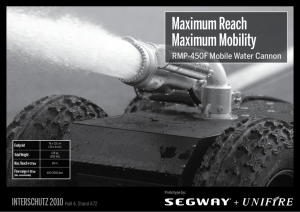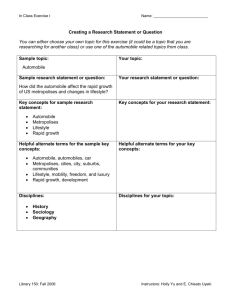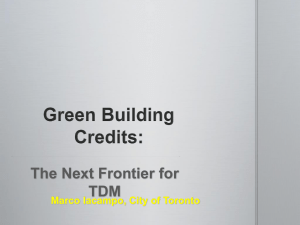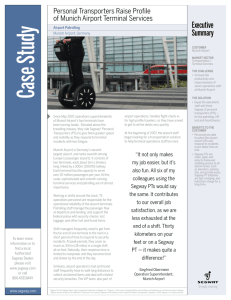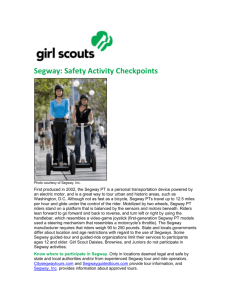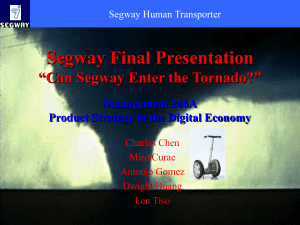12/17/01 & 12/24/01 - Magplane Technology, Inc.
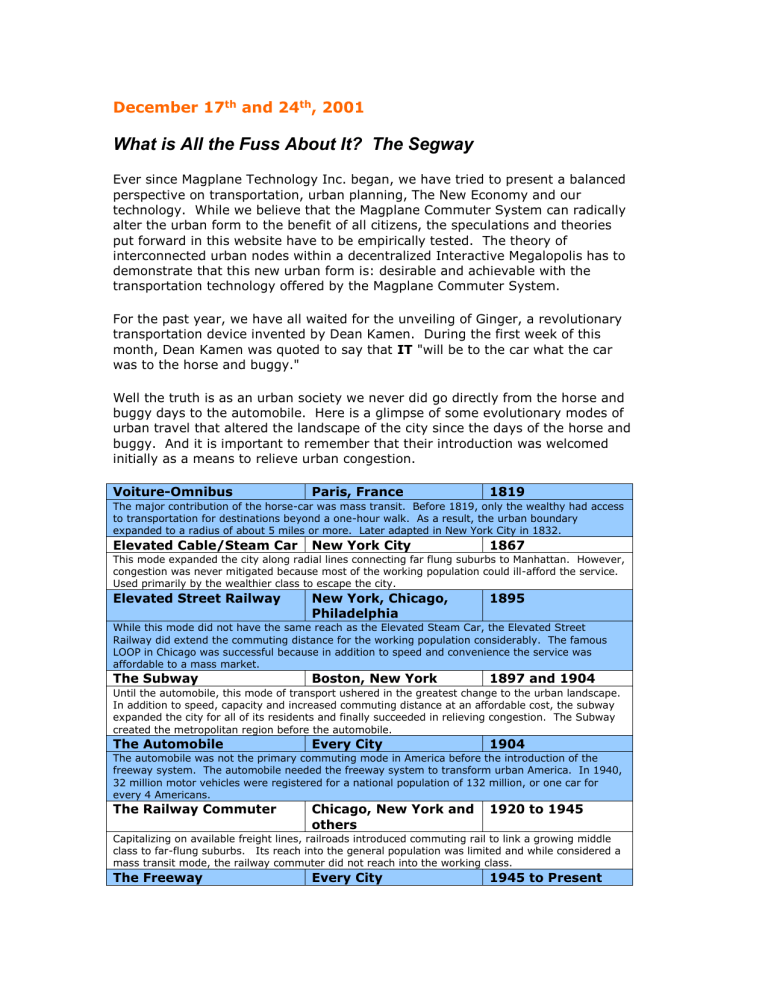
December 17 th and 24 th , 2001
What is All the Fuss About It? The Segway
Ever since Magplane Technology Inc. began, we have tried to present a balanced perspective on transportation, urban planning, The New Economy and our technology. While we believe that the Magplane Commuter System can radically alter the urban form to the benefit of all citizens, the speculations and theories put forward in this website have to be empirically tested. The theory of interconnected urban nodes within a decentralized Interactive Megalopolis has to demonstrate that this new urban form is: desirable and achievable with the transportation technology offered by the Magplane Commuter System.
For the past year, we have all waited for the unveiling of Ginger, a revolutionary transportation device invented by Dean Kamen. During the first week of this month, Dean Kamen was quoted to say that IT "will be to the car what the car was to the horse and buggy."
Well the truth is as an urban society we never did go directly from the horse and buggy days to the automobile. Here is a glimpse of some evolutionary modes of urban travel that altered the landscape of the city since the days of the horse and buggy. And it is important to remember that their introduction was welcomed initially as a means to relieve urban congestion.
Voiture-Omnibus Paris, France 1819
The major contribution of the horse-car was mass transit. Before 1819, only the wealthy had access to transportation for destinations beyond a one-hour walk. As a result, the urban boundary expanded to a radius of about 5 miles or more. Later adapted in New York City in 1832.
Elevated Cable/Steam Car New York City 1867
This mode expanded the city along radial lines connecting far flung suburbs to Manhattan. However, congestion was never mitigated because most of the working population could ill-afford the service.
Used primarily by the wealthier class to escape the city.
Elevated Street Railway New York, Chicago,
Philadelphia
1895
While this mode did not have the same reach as the Elevated Steam Car, the Elevated Street
Railway did extend the commuting distance for the working population considerably. The famous
LOOP in Chicago was successful because in addition to speed and convenience the service was affordable to a mass market.
The Subway Boston, New York 1897 and 1904
Until the automobile, this mode of transport ushered in the greatest change to the urban landscape.
In addition to speed, capacity and increased commuting distance at an affordable cost, the subway expanded the city for all of its residents and finally succeeded in relieving congestion. The Subway created the metropolitan region before the automobile.
The Automobile Every City 1904
The automobile was not the primary commuting mode in America before the introduction of the freeway system. The automobile needed the freeway system to transform urban America. In 1940,
32 million motor vehicles were registered for a national population of 132 million, or one car for every 4 Americans.
The Railway Commuter Chicago, New York and 1920 to 1945 others
Capitalizing on available freight lines, railroads introduced commuting rail to link a growing middle class to far-flung suburbs. Its reach into the general population was limited and while considered a mass transit mode, the railway commuter did not reach into the working class.
The Freeway Every City 1945 to Present
More accurately, it was this innovation that expanded the urban limits dramatically, redesigning our cities. Its impact to the urban landscape is felt greatest in cities that experienced substantial population increases, such as the Southwest. By 1990, America had 138 million motor registered vehicles for a population of 249 million or one car for roughly every 1.4 Americans. Eventually and very soon, statisticians estimate that there will be one registered motor vehicle for every US citizen.
According to the newest numbers from the Census: cars, trucks and vans carried 111.7 million commuters to work--87.5 percent of all work trips in 2000.
Obviously the claim that IT can replicate the revolutionary impact of the horse and buggy to automobile eras is a stretch at best. According to John Landis of the University of California at Berkeley if the Segway is to impact the urban landscape significantly, "It has to be either faster or more convenient". "It may be, but it isn't now. Now it's nothing more than a one-wheeled motorcycle."
For every transportation evolution listed above, the congestion of the city was lessened through expansion as the new travel mode made more distant destinations accessible. The Segway on the other hand, does not expand commuting ranges for all citizens. Rather, it is targeted at pedestrians, and short distance public transport travelers and motorists. The success of the Segway is dependent on modal conversions not in inducing new travel.
For the sake of the employers and the employees of the New Economy, let us hope that Mr. Kamen is somewhat too optimistic because if cities do reorganize urban activities to promote the use of this device, then the contraction of the metropolis is all but inevitable. The arrival of the Segway is perfectly timed to exploit the growing backlash against the automobile and long distance work commuting. In fact, the inventor is pinning the hopes of the company on the contraction of the city and the banishment of the automobile from the central city.
By traveling at three or four times walking speed, and thus turning what would have been a 30-minute walk into a 10-minute ride, Kamen contends, Segways will in effect shrink cities to the point where cars
"will not only be undesirable, but unnecessary." http://www.time.com/time/business/printout/0,8816,186660,00.html
The collapse of our cities if it were to occur, will be counterproductive to the economic well being of our urban economies. Rather than increasing economies of scale of an increasingly specialized labor force, the Segway may decrease labor accessibility at a time when the capital value of labor is greater than the capital value of fixed assets. As well, the contraction of the urban form will aggravate the spatial segregation of economic classes resulting in an ever more isolated working class. Urban planners learned this lesson in the aftermath of the 1965
Watts riots, when poor transportation links isolated this community with tragic results.
However, the Segway does hold very significant potential for many transportation markets: Shopping Malls; Postal Service; Policing and Security; Military; Airports and Industrial Plants/Wharehouses.
We at Magplane Technology Inc. have always looked to the subway and the impact it had on our cities as a transportation model to emulate. Because its
transportation attributes with the exception of speed comes closest to the transportation service needed to convert existing intercity travel markets into time, cost, and convenience equivalent intracity commuting markets. This conversion of current inter-city travel markets will improve the integration of adjacent urban economies leading to improved labor productivity for New
Economy industries. And it is this central objective that will demonstrate the desirability of the Magplane Commuter System.
But perhaps the most optimistic comment about the Segway comes from Tim
Lougheed of the Southam Newspapers in Canada and we at Magplane hope that this journalist will be proven right.
“More important Kamen wants it to capture other people’s imaginations, leading them to think about these social, political and environmental problems in a different way. ‘This new technology fills a wide gap in the current transportation continuum and gives us the power to solve many to solve many of the problems, created by rapidly growing megacities,’ he says.”
“There may be more to these words than mere rhetoric. The power to which he refers may have nothing to do with the HT and its success as a product. Instead, it may simply be the power of opening up people’s minds to alternatives, unusual or even downright bizarre posed by our
conventional transportation options.”
Tim Lougheed, Southam Newspapers, December 17 th , 2001
When you look under the tree this Christmas, will you be looking for IT?
